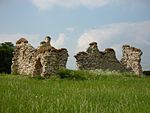King John's Palace is the remains of a former medieval royal residence in Clipstone, north-west Nottinghamshire. The name "King John's Palace" has been used since the 18th century; prior to that the site was known as the "King's Houses". It is not known how or when the building became associated with King John as he only spent a total of nine days here.
The earliest reference to the King's Houses dates back to 1164 during the reign of Henry II (1154–1189). The first period of significant building took place between 1176 and 1180, when Henry ordered £500 to be spent, and also created a deer park at Clipstone. Hunting game was the preserve of the aristocracy and deer parks provided a form of recreation, foodstuffs for feasting and an arena for crucial political and economic deals to be made. In 1194 Richard I arranged a meeting with William, King of Scots at Clipstone, and in 1290, Edward I convened Parliament here.
The King's Houses were once very well-appointed. The ruins that are visible today are the remains of a Romanesque chamber dating from around 1180. The stone chamber was accessed through a large, buttressed central doorway and had a timber upper floor which allowed views over the deer park from ornately carved windows. However, the chamber was only a small part of a large, multiphased complex of buildings which is known to have existed at Clipstone from documents, geophysical survey and archaeological excavation. These included a gatehouse, tower, individual hall and chambers for the King and Queen, several chapels, kitchens, stables for 200 horses, and lodgings for many royal retainers. There was also a Great Pond which provided 100 pike and 1600 roach during Edward II's visit in December 1315.
Clipstone remained an important royal centre until the late fifteenth century when the English monarchy began to focus on other residences. In 1525 it was said of the King's Houses that "ther is great dekay & ruyne in stone-work tymber lede and plaster". By the mid-18th century, the site had been reduced to the ruin that stands today.
King John's Palace was consolidated during 2009 by Paul Mendham Stonemasons during a conservation project funded by English Heritage and Nottinghamshire County Council. The site is the focus of an ongoing archaeological project by Andy Gaunt of Mercian Archaeological Services and the buildings archaeologist James Wright.










